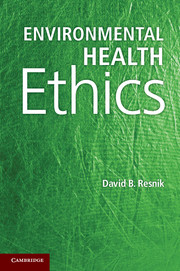Book contents
- Frontmatter
- Contents
- Figures and Tables
- Acknowledgments
- Abbreviations
- 1 Introduction
- 2 An Overview of Environmental Health
- 3 Ethical Theory
- 4 Toward an Environmental Health Ethics
- 5 Pest Control
- 6 Genetic Engineering, Food, and Nutrition
- 7 Pollution and Waste
- 8 The Built Environment
- 9 Climate Change, Energy, and Population
- 10 Justice and Environmental Health
- 11 Environmental health Research Involving Human Participants
- 12 Conclusion
- References
- Index
8 - The Built Environment
Published online by Cambridge University Press: 05 July 2012
- Frontmatter
- Contents
- Figures and Tables
- Acknowledgments
- Abbreviations
- 1 Introduction
- 2 An Overview of Environmental Health
- 3 Ethical Theory
- 4 Toward an Environmental Health Ethics
- 5 Pest Control
- 6 Genetic Engineering, Food, and Nutrition
- 7 Pollution and Waste
- 8 The Built Environment
- 9 Climate Change, Energy, and Population
- 10 Justice and Environmental Health
- 11 Environmental health Research Involving Human Participants
- 12 Conclusion
- References
- Index
Summary
As we have seen in previous chapters, location has a significant impact on exposure to environmental health risks. Where one lives or works can affect one’s exposure to air and water pollutants, pesticides, solid waste, and industrial chemicals. In this chapter, we will focus on health risks related to the built environment, which includes all of the structures that people create to support different functions and activities, such as work, recreation, education, transportation, habitation, agriculture, and industry. The built environment includes houses, apartments, office buildings, factories, schools, malls, roads, levies, dams, mines, sidewalks, fields, waste disposal sites, and many more structures (Frumkin et al. 2004). In the last 10,000 years, human beings have radically transformed the landscape of the planet by clearing land, erecting buildings, creating cities, and damming rivers.
In thinking about the built environment, three trends are worth noting. First, the human population has grown from about 125,000 people at 1 million years BCE, to 5 million people in 10,000 BCE, to about 7 billion people today. The human population is expected to grow to 9 billion people by 2050 (United Nations 2009). As the population continues to increase, more houses, schools, roads, dams, and other structures will need to be built to accommodate more people, which will increase humanity’s impacts on the environment.
- Type
- Chapter
- Information
- Environmental Health Ethics , pp. 158 - 170Publisher: Cambridge University PressPrint publication year: 2012

